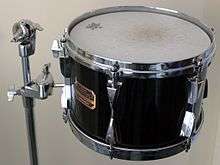Wingnut (hardware)
A wingnut or wing nut is a type of nut with two large metal "wings", one on each side, so it can be easily tightened and loosened by hand without tools.
A similar fastener with a male thread is known as a wing screw[1][2] or a wing bolt.[3]
 Three wingnuts
Three wingnuts Bicycle wingnuts
Bicycle wingnuts Three wingnuts securing a cymbal and its mounting
Three wingnuts securing a cymbal and its mounting Three wingnuts and wingbolts supporting a drum
Three wingnuts and wingbolts supporting a drum
Types
ASME B18.6.9 classifies wing nuts first by manufacturing method and then by style.
- Type A are cold forged or cold formed produced in regular, light and heavy dimensional series.
- Type B are hot forged solid nuts available in three different wing styles.
- Type C are die cast nuts available in three wing styles with variances between regular and heavy dimensional series
- Type D are stamped sheet metal nuts available in three wing styles.
Bicycles
Before the development of quick release skewers, bicycle wheels were held in place with wingnuts.[4][5]
Drum hardware
In a drum kit wingnuts and wingbolts are used extensively.
- For securing a suspended cymbal on the mounting bolt of a cymbal stand.
- For securing an adjustment on a stand.
- In connection with memory.
Memory
In drum hardware, memory refers to any system that preserves the adjustment of a stand, boom or bracket when the kit is disassembled.
Most commonly this takes the form of a collar on a tube, fixed in place by a screw operated by a drum key. This collar mates with a fitting that receives the tube and secures it by means of a wingnut or wingbolt. When the stand is disassembled, only the wingnut or wingbolt needs to be loosened, and the collar remains in place, allowing the stand to be reassembled in exactly the same adjustment. When the stand needs to be adjusted, the collar is first loosened by means of a drum key.
Seltzer bottle
The device that surrounds a CO2 cartridge in a seltzer bottle is also a wingnut. Twisting the wingnut completes a seal around the cartridge neck; twisting a bit more causes a pin to pierce the cartridge and let the gas into the bottle.
See also
References
| Wikimedia Commons has media related to Wing nuts. |
- ↑ https://www.fastenal.com/products?term=wingscrew&searchMode=productSearch
- ↑ http://www.grainger.com/category/thumb-screws/screws/fasteners/ecatalog/N-8ndZ1z0koj5 uses "thumb screw, wing"
- ↑ http://www.merriam-webster.com/dictionary/wing%20bolt
- ↑ Brown, Sheldon. "Quick-release Wheels". Sheldon Brown. Retrieved 2011-07-11.
In 1927, Tullio Campagnolo was unable to reverse the rear wheel of his bicycle to change gears while racing over the Croce d'Aune pass in the Italian Alps. His frozen fingers were unable to loosen the wingnuts used to hold his wheels in place. This incident led to his invention of the quick release.
- ↑ Brown, Sheldon. "Singlespeed Conversions - Solid-Axle vs Quick Release". Sheldon Brown. Retrieved 2011-07-11.